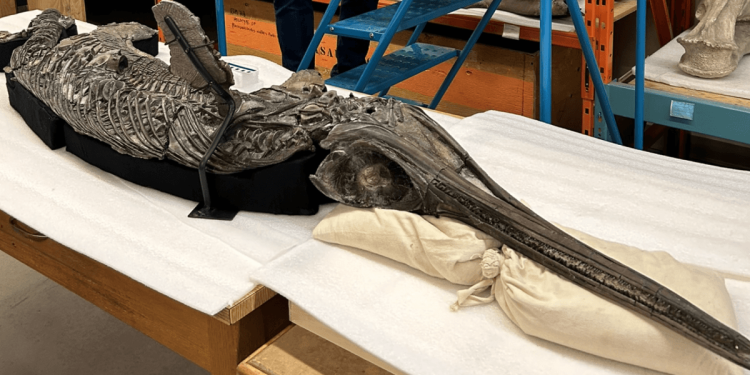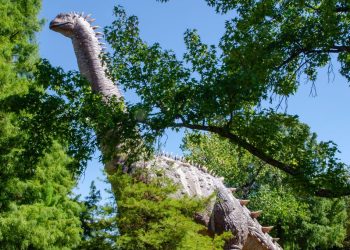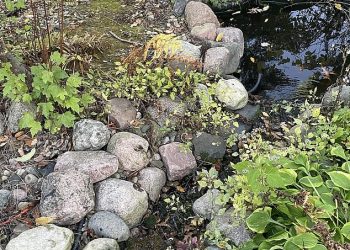One of the most complete sea monsters ever recorded has been discovered along the UK’s Jurassic coast. It is perhaps the most complete reptile fossil in the world dating back to the Pliensbachian period. This rare and impressive specimen offers an unprecedented insight into a period we know little about and fills a gap in our understanding of a strange and complex faunal turnover that was occurring at the time, around 190 million years ago.
This species new to science is an ichthyosaur nicknamed “Dorset Sword Dragon”, and its scientific name is just as impressive: Xiphodracon goldencapensis. It was estimated to be 3 meters (9.8 feet) long and was discovered by fossil collector Chris Moore, who you may remember from this huge pliosaur skull discovery a while back.
In most ichthyosaurs, the bones often become flattened and quite two-dimensional, but these remained completely three-dimensional.
Chris Moore
“I spotted part of the tail vertebrae sticking out, then I covered it up and got permission to dig down and take a look at what was there,” he said. “I followed the vertebrae and it continued, then I found the rear paddles, and it continued: the ribcage was there, the front paddles, and then I reached the skull.”
“I hit this hard object, which turned out to be the skull, and it was preserved in three dimensions. In most ichthyosaurs, the bones often become flattened and quite two-dimensional, but these remained completely three-dimensional. The skull had the two eyes on either side, and then this massive, long, sword-shaped rostrum with hundreds of little needle-like teeth.”
Falling into a toxic gloop sucks for prehistoric animals, but it’s great news for fossil fans.
Image credit: Dr. Dean Lomax
This excellent preservation is a hallmark of this region which was once a shallow tropical sea teeming with life. In addition to being home to many ichthyosaur favorite foods like ammonites, fish, and belemnites (hence why so many are found here), it also had a mostly anoxic seafloor. This meant that when animals died and sank to the bottom, they fell into the poisonous mud where nothing could disturb their remains. Good advice if you want to become a fossil.
Moore described the discovery as “in the mists of time”, which is significant given that there was a 24-year gap between its discovery and formal identification. Asked if this was unusual, Moore replied: “It’s exceptionally long, but in geological times I guess it’s nothing.” »
This helps to somewhat fill the void for ichthyosaurs during this pivotal stage of their evolution.
Dr. Dean Lomax
This gap occurred because the specimen was sent to the Royal Ontario Museum, where world-renowned ichthyology expert Dr. Chris McGowan worked. For some reason the specimen was not drawn up, and after McGowan retired, fellow ichthyology specialist Dr Dean Lomax asked Moore if he could take a look.
Now, a new paper on the fossil has revealed that this ichthyosaur is a species new to science, and incredibly rare. You see, even though we have found thousands of complete or nearly complete ichthyosaurs from before and after the Pliensbachian, we have virtually none that lived during this period.
The original specimen remains in Ontario, but Moore told me he has since found a second specimen on display at the Charmouth Heritage Coast Center in Dorset, UK. “We nicknamed him Gonzo because of his deformed jaw,” he said. “Result of a dive into seafloor sediments 190 million years ago.”

The Dorset sword dragon’s impressive teeth were adapted for hunting squid and fish.
Image credit: Dr. Dean Lomax
This is a particularly critical window in our understanding of the Jurassic timeline, because at this time something significant was happening that led to a massive and complex turnover of terrestrial fauna and the evolution of ichthyosaurs. So, does anyone know what prompted this chaotic change?
“Weirdly, we don’t,” Lomax told IFLScience. “That’s what makes this new discovery very special, as it helps to sort of fill the gap for ichthyosaurs during this crucial stage of their evolution.”
The specimen will help us lock in when this big change happens, but it has plenty more to offer in terms of unique features, and may even contain preserved stomach contents.

This fossil is the only one of its type ever discovered and perhaps the most complete reptile from this geological period that we have ever found.
Image credit: Dr. Dean Lomax
“There are a lot of interesting features with this fossil,” Lomax said. “If I were forced to choose just a few, I would say that the extremely long, sword-like snout and massive eye are truly – pun intended – eye-catching.”
“Looking into its eyes and looking at its long jaws with thin, sharp teeth, you can really imagine this animal in life, hunting fish and squid. I would also say that a bone around the nostril opening, called a lacrimal, is super weird. We’ve never seen something like this before in an ichthyosaur.”
And if you have any weird and unique fossils, you might want to take a look at the two-headed prehistoric creature that graces the cover of Lomax’s latest book, The secret life of dinosaurs.
The study is published in the journal Papers in Palaeontology.









